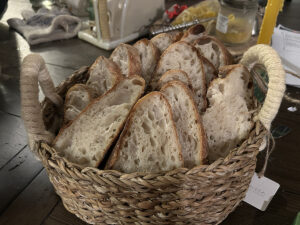Cooking is one of my favorite ways to spend time, and international recipes are my absolute favorites to cook! I love putting together unexpected ingredients and ending up with something delicious and adventurous. In this second installment of my series on international recipes, we are going to travel to Asia!
I love all kinds of Asian foods. I love Chinese sesame and orange chicken, Thai stir-fried noodles, Indian curry, and Japanese hibachi grilled seafood. When I was in Indonesia, where I went with the organization Youth Venture for two weeks to help teach school children English, I couldn’t get enough of the satay and fried rice that were served there. I absolutely loved getting to truly experience another culture’s foods in such an immersive way. Asia has so many different regions, each of them offering their own unique and delicious foods. In this blog, I want to highlight some recipes from my personal favorite Asian cuisine – Korean.
I haven’t ever traveled to Korea, but I still feel like I have experienced a little bit of their culture, through exploring the recipes that are common there. Korean food uses a huge range of ingredients, including all kinds of vegetables, meats, and seafood. This gives Korean dishes incredible flavor, and a diverse menu of things to choose from.
My favorite Korean dish to make myself is their classic bibimbap. Bibimbap is a Korean rice bowl that not only looks beautiful once prepared, but tastes even better. It’s a very customizable recipe, allowing for any spice preference. At first, this recipe may look daunting because it may have some components you aren’t used to seeing. Believe me, though, after a time or two of making this dish, it becomes very simple and easy to remember.
Print
The Spruce Eat’s Classic Korean Bibimbap
Ingredients
- 2 cups medium-grain Korean rice (or Japanese rice)
- 1 large cucumber (sliced into thin strips)
- 1 1/2 cups bean sprouts (parboiled and squeezed of excess water)
- 1 1/2 cups spinach (parboiled and squeezed of excess water)
- Dash of sesame seeds
- 2 carrots (julienned)
- 4 shiitake mushrooms (rehydrated if dried and then sliced)
- 1 zucchini (sliced into thin strips)
- 2 tablespoons sesame oil (divided)
- 2 teaspoons salt (divided)
- 1/2 pound meat, optional (both raw and cooked ground meat work well)
- Fried egg, optional
- Gochujang, for serving (red pepper)
Instructions
- Fully cook the rice in a rice cooker or on a stove.
- Next, give the cucumber strips a saltwater bath for 20 minutes. Drain the cucumbers using a sieve.
- Then, season spinach with 2 teaspoons sesame oil, 1 teaspoon salt, and a dash of sesame seeds.
- Season bean sprouts with 2 teaspoons sesame oil, 1 teaspoon salt, and a dash of sesame seeds.
- You’ll then need to sauté the carrots, mushrooms, and zucchini with a dash of salt, until soft.
- Then, place the cooked rice in a large bowl and arrange vegetables on top. If desired, beef, tofu, and/or a soft fried egg can be added.
- Serve each helping with small bowls of gochugang and sesame oil. To eat, add a small amount of oil and desired amount of gochujang to your bowl and mix everything together with a spoon.
- Author: The Spruce Eats
Another classic and delicious Korean recipe that I love to order in restaurants (pre-COVID, of course) and make myself at home is Korean pork belly lettuce wraps. These savory wraps take a bit of time to prepare, but they are more than worth it. If the meat and optional pickled vegetables are prepared ahead of time and stored in the fridge or freezer, then this recipe can come together very quickly for a tasty dinner.
Print
The Spruce Eat’s Korean Pork Belly (Bossam)
Ingredients
For the pork:
- 3 ounces whole ginger root
- 3 tablespoons doenjang (Korean soybean paste)
- 1 onion (quartered)
- 4 scallions (white parts only, roughly chopped)
- 6 garlic cloves (smashed)
- 2 tablespoons honey
- 1 teaspoon gochujang (Korean chile paste)
- 2 1/2 pounds skin-on pork belly
For the sauce:
- 2 tablespoons doenjang
- 1 tablespoon gochujang
- 1 tablespoon mirin
- 1 teaspoon sesame oil
- 1 clove garlic (finely grated)
- 2 teaspoons sesame seeds
For optional pickled radish:
- 8 ounces Korean white radish (peeled and julienned)
- 2 tablespoons Korean apple vinegar (or rice vinegar)
- 2 tablespoons sugar
- 2 teaspoons ground Szechuan chile peppers
- 1 clove garlic (finely grated)
- 2 teaspoons kosher salt
For serving:
- Steamed white rice
- Whole leaf lettuce
Instructions
- Finely grate 1 ounce of the whole ginger, and cut the other 2 ounces into a few large chunks.
- Add the prepared garlic, doenjang, onion, scallions, garlic cloves, honey, gochujang, and pork belly to a 5 quart (or larger) pot with lid. Add water to cover the pork belly.
- Stirring occasionally to distribute the ingredients, bring to a boil over high heat. Reduce to a simmer, cover, and cook for about 2 hours.
- To prepare the optional but delicious pickles, simply combine white radish, Korean apple vinegar, sugar, ground Szechuan chile peppers, clove, and Kosher salt in a bowl and refrigerate until ready to serve.
- Preheat oven to 350 F.
- When the pork belly is done, transfer the meat to a foil-lined baking sheet. Discard the cooking liquid along with the aromatics.
- Roast the pork in the oven for about 30 minutes. While the pork is roasting, steam your rice.
- Mix all the sauce ingredients together in a small bowl.
- Wash and dry the lettuce and perilla leaves. Arrange on platters.
- When the pork belly is caramelized, slice as desired and serve immediately with all accompaniments.
- Author: The Spruce Eats
I hope this gives you some new ideas for Asian recipes to add to your to-cook list. I absolutely love the diverse and incredible dishes that Asia, more specifically Korea, has to offer. Remember to think outside the box, and your borders, when choosing what to cook next!































